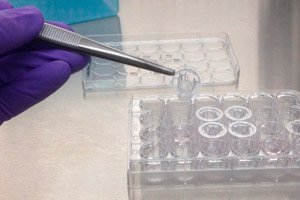
All iLive content is medically reviewed or fact checked to ensure as much factual accuracy as possible.
We have strict sourcing guidelines and only link to reputable media sites, academic research institutions and, whenever possible, medically peer reviewed studies. Note that the numbers in parentheses ([1], [2], etc.) are clickable links to these studies.
If you feel that any of our content is inaccurate, out-of-date, or otherwise questionable, please select it and press Ctrl + Enter.
The lab will grow artificial skin
Last reviewed: 02.07.2025
 ">
">At one Brooklyn startup, experts are busy creating artificial leather – the animal material of the future, created according to the principle “Grown, not killed!”
According to the head of the company Modern Meadow Andras Forgács, such artificial leather can be seen on the market much earlier than artificial meat (which, by the way, scientists have already learned to grow in laboratory conditions). Most likely, this is due to the fact that people will accept new technologies in clothing faster than on their own plates, in addition, stricter standards have been developed for food products.
In addition, for manufacturers (for example, bags, clothes, car seats, etc.), the new technology can be quite useful.
The price of leather has increased significantly in recent years, and there is currently a significant imbalance between supply and demand, as more and more people with average incomes can afford to buy leather goods.
According to Forgach, today's leather production process is dirty and inefficient. In some cases, a single animal may be killed solely for the leather (leather was originally sold as a by-product of an animal slaughtered for meat).
The leather industry is quite polluting, especially in developing countries. In addition, large quantities of leather end up as scraps and are thrown away at the end of the production process.
To grow artificial leather in a laboratory, specialists need a small tissue sample (for example, a skin biopsy from an ostrich, cow, crocodile, etc.). Then experts isolate the cells and multiply them, resulting in leather tissue in the form of sheets.
The head of the company noted that specialists are capable of growing the skin of almost any animal. Now the developers are working on maximizing the production of collagen, which is the main building block of the skin. During the growing process, sheets are superimposed on each other, and the collagen creates a fibrous structure, which makes the artificial skin look very similar to real skin, but without any admixtures of fat, flesh, hair, glands, etc. In addition, fewer chemicals are required to give the artificial skin the structure necessary for wearing.
The first prototypes of artificial leather were created by the company's specialists back in 2013, and now the researchers are working on improving their product.
Lab-grown leather will open up new possibilities for designers. Since the process of growing artificial leather starts practically from scratch, it is possible to create a wide variety of shapes and types, while obtaining a finished product with minimal production costs.
The company's specialists are currently developing a material that will be stronger and thinner than regular leather. The researchers plan to create leather in three dimensions, which will allow designers to create complex shapes without seams and waste.
